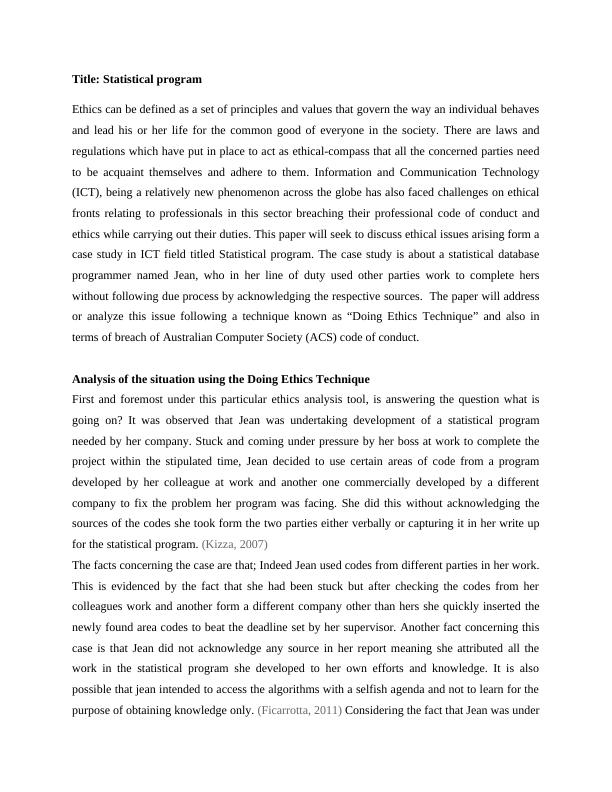Statistical program Ethics PDF
9 Pages3020 Words50 Views
Added on 2020-03-16
Statistical program Ethics PDF
Added on 2020-03-16
ShareRelated Documents
UNIVERSITY NAME Student’s name Student’s IDProfessional Practice

Title: Statistical programEthics can be defined as a set of principles and values that govern the way an individual behavesand lead his or her life for the common good of everyone in the society. There are laws andregulations which have put in place to act as ethical-compass that all the concerned parties needto be acquaint themselves and adhere to them. Information and Communication Technology(ICT), being a relatively new phenomenon across the globe has also faced challenges on ethicalfronts relating to professionals in this sector breaching their professional code of conduct andethics while carrying out their duties. This paper will seek to discuss ethical issues arising form acase study in ICT field titled Statistical program. The case study is about a statistical databaseprogrammer named Jean, who in her line of duty used other parties work to complete herswithout following due process by acknowledging the respective sources. The paper will addressor analyze this issue following a technique known as “Doing Ethics Technique” and also interms of breach of Australian Computer Society (ACS) code of conduct. Analysis of the situation using the Doing Ethics Technique First and foremost under this particular ethics analysis tool, is answering the question what isgoing on? It was observed that Jean was undertaking development of a statistical programneeded by her company. Stuck and coming under pressure by her boss at work to complete theproject within the stipulated time, Jean decided to use certain areas of code from a programdeveloped by her colleague at work and another one commercially developed by a differentcompany to fix the problem her program was facing. She did this without acknowledging thesources of the codes she took form the two parties either verbally or capturing it in her write upfor the statistical program. (Kizza, 2007)The facts concerning the case are that; Indeed Jean used codes from different parties in her work.This is evidenced by the fact that she had been stuck but after checking the codes from hercolleagues work and another form a different company other than hers she quickly inserted thenewly found area codes to beat the deadline set by her supervisor. Another fact concerning thiscase is that Jean did not acknowledge any source in her report meaning she attributed all thework in the statistical program she developed to her own efforts and knowledge. It is alsopossible that jean intended to access the algorithms with a selfish agenda and not to learn for thepurpose of obtaining knowledge only. (Ficarrotta, 2011) Considering the fact that Jean was under

pressure to deliver the work form her boss at the company and also considering the possibilitythat jean never wanted to look incompetent before her boss, she could have decided to fix herproblem with the boss before time elapses and deal with the rest of the issue latter. If she haddecided to follow the right procedure of studying the algorithms from the two foreign parties andusing the knowledge gained to develop her own original area codes then she could have ran outof time and be in trouble with her boss at work. On the other hand, if she had decided use thearea codes the way they were at their sources and acknowledge this in her write up, then shecould have feared that her boss may deem her incompetent. Thus the two scenarios supports thenotion that Jean used someone’s or some entity’s intellectual property for the purposes of beatingthe deadline and ensuring her boss believe in her work by claiming 100% originality of thestatistical software she developed. In the contrary is also possible that Jean upon gainingknowledge from the algorithms she studied from her colleague work developed the codes and co-incidentally came up with the same areas of codes as contained in the two sets of work shestudied. (Mendina & Britz, 2011)There are a number of issues that arises from the case study under discussion. (a)Ownership – Jean did not acknowledge the sources she used in her work. Some of thearea codes she used belonged to her colleague at work while other codes were owned bya different company from what she was working for. Therefore, by not mentioning themJean failed the ethical issue of attributing the knowledge she used to its owners.(Manning and Stroud, 2008)(b)Integrity issue – Jean failed the integrity issue by giving false information regarding herwork to her company. She ought to have mentioned in her report that she used otherparties’ knowledge to come up with her program, instead she attributed all the work ofher statistical software to her own effort which was misrepresentation of facts an integrityissue. (Manning and Stroud, 2008)(c)Transparency – Jean ought to have told her supervisor that indeed she can not pushthrough something she thinks she has it all but still not being able to come up with thesolution on her own. She should have frank with her boss about her inability to continueunless she uses someone work to fix her problem or take more time than what wasavailable to be able to crack the challenge she was facing. (Manning and Stroud, 2008)

End of preview
Want to access all the pages? Upload your documents or become a member.
Related Documents
ICT Professional Practice and Ethics : Assignmentlg...
|12
|2972
|30
ICT351 ICT Professional Practice Assignmentlg...
|12
|3068
|314
ICT Professional Practice Assignmentlg...
|14
|3147
|52
Case Study of the Statistical Programlg...
|13
|3137
|174
Professional Issues of IT - Deskliblg...
|9
|2231
|390
Ethical issues arising from the use of ICT technologies: Jean’s Scenariolg...
|6
|1707
|374
